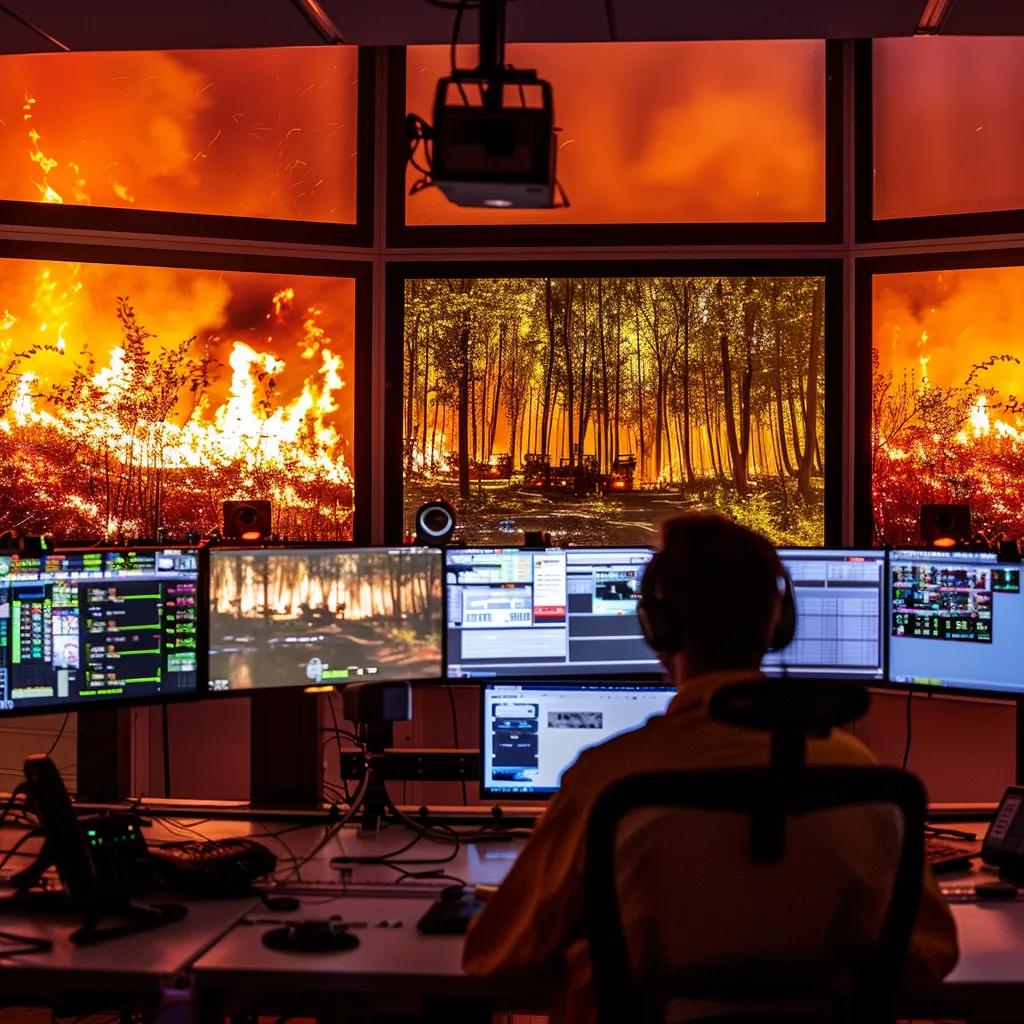
How Computer Vision Transforms Forest Fire Surveillance
Understanding Computer Vision’s Impact on Forest Fire Detection
Forest fires threaten natural ecosystems and human developments alike. This article outlines how computer vision ai is revolutionizing forest fire detection by integrating advanced algorithms, high-resolution imagery, and predictive analytics. It examines the science behind these systems, the benefits and challenges of their deployment, and real-world applications and trends that improve early detection and response. This analysis is vital for researchers, forest management agencies, and technology developers aiming to protect our forests using data-driven approaches.
Discover How Computer Vision Transforms Forest Fire Detection Techniques
Computer vision decodes and interprets images using machine learning models to detect anomalies. For fire detection, these models analyze smoke patterns, vegetation changes, and thermal imagery by processing large datasets from satellites and drones with convolutional neural networks (CNNs). Techniques such as data augmentation and regularization reduce false alarms and improve prediction accuracy.
Understand the Basics of Computer Vision in Environmental Science
Computer vision converts raw image data into actionable information. In the pre-processing stage, raw images are enhanced by adjusting the color space and reducing noise to reveal fine details such as smoke plumes or heat spots. Subsequent segmentation and feature extraction isolate important aspects—like shape, texture, and color—that help distinguish harmless phenomena (e.g., fog or haze) from actual fires.
Identify the Key Technologies Used in Fire Detection
Key technologies include thermal imaging cameras, satellite and drone sensors, and advanced algorithms like CNNs and generative adversarial networks. High-resolution satellite imagery offers a broad view of forests, while drones provide real-time details in high-risk areas. These devices, coupled with remote sensing techniques, collect data processed by algorithms trained to recognize fire-specific features. Research institutions, including NASA, have demonstrated increased early detection rates and fewer false alarms using these methods.
Examine Real-World Applications of Computer Vision in Forestry
Around the globe, computer vision systems monitor forest landscapes effectively. In the Mediterranean, for example, systems continuously analyze live images against historical data. When a sudden increase in heat signatures or smoke patterns is detected, local fire management receives an immediate alert. Unmanned aerial vehicles (UAVs) further enhance detection precision, enabling quick responses that have reduced property loss and saved resources during seasonal fire events.
Recognize the Challenges in Implementing These Technologies
Challenges in deploying computer vision for fire detection include environmental factors like heavy fog, dense smoke, and variable topography, which can complicate image capture. Overfitting in machine learning models may limit their generalizability across diverse ecosystems. High computational costs, data management issues, limited telecommunications in remote areas, and privacy concerns associated with aerial surveillance further complicate adoption. Additionally, the initial investment required for these advanced systems can be substantial.
Learn About Recent Innovations in Fire Detection Methods
Recent innovations leverage deep learning to enhance both detection accuracy and response speed. Generative adversarial networks (GANs) efficiently synthesize large training datasets from limited real-world examples, while unsupervised learning techniques continuously update models with new environmental data. These advances lower false alarm rates and enable the detection of smaller fires that might otherwise be overlooked until they grow.
Assess the Future Trends in Computer Vision for Fire Monitoring
Emerging trends suggest that the convergence of drone technology, Internet of Things (IoT) devices, and advanced AI will create a new era in fire detection. Predictive analytics and hyperparameter tuning will lead to systems capable of not only detecting fires but also predicting them based on historical and environmental signals. Cloud and edge computing will enable real-time processing in remote areas. Future systems may integrate data from weather satellites, ground sensors, and aerial drones to comprehensively monitor wildfires.
Analyze the Benefits of Computer Vision in Fire Management
Computer vision enhances fire management by improving detection speed, accuracy, and resource efficiency. It transforms traditional, labor-intensive monitoring into an automated, data-driven process, enabling the early detection of fires and minimizing damage and firefighting costs.
Improve Early Detection Rates Through Advanced Algorithms
Advanced algorithms process thousands of images per minute, reducing the time between ignition and detection. Early detection is critical because each minute saved can slow fire spread. High-resolution image analysis detects even the smallest signs of fire, enabling faster deployment of firefighting resources and improving safety for both the public and firefighters.
Enhance Data Accuracy With High-Resolution Imagery
High-resolution sensors provide detailed images that help computer vision systems discern between natural landscape variations and abnormal fire indications. Multispectral imaging, which examines thermal, visible, and infrared wavelengths simultaneously, ensures accurate assessment of fire intensity and spread. Data augmentation techniques further mitigate errors from noise or poor lighting.
Optimize Resource Allocation Using Predictive Analytics
Predictive analytics forecast potential fire outbreaks by analyzing historical and real-time data. Machine learning models identify patterns that precede fires, allowing for the strategic positioning of firefighting personnel and equipment. This proactive resource distribution minimizes operational losses and improves overall emergency response.
Reduce Response Times and Increase Firefighting Efficiency
Automated alerts driven by real-time image analysis reduce response times significantly. Quick notifications enable rapid mobilization of firefighting resources, limiting fire spread. Studies have shown that regions using these technologies experience a 20–30% reduction in response times, which correlates with better protection of both human life and natural resources.
Foster Collaboration Between Technology and Environmental Agencies
The use of computer vision fosters collaboration between technology providers and environmental agencies. By sharing data, methodologies, and best practices, these partnerships improve detection protocols and standardize data acquisition techniques. Such collaborative efforts drive innovation and enhance the overall robustness of fire detection systems.
Evaluate Cost-Effectiveness of Computer Vision Solutions
Though the initial costs for computer vision systems can be high due to advanced sensors and computational infrastructure, long-term savings are significant. Reduced fire damage, lower operational costs, and improved resource allocation contribute to a decrease in overall fire management expenses—often by around 25% compared to traditional methods.
Explore Case Studies Highlighting Computer Vision Successes
Case studies from various regions illustrate the practical benefits of computer vision in wildfire management by providing performance metrics and real-world examples.
Review Notable Forest Fire Detection Projects Globally
In California, advanced computer vision systems deployed across forested areas have delivered early warning signals through the integration of satellite and drone data. Similar projects in Australia and the Mediterranean have achieved improved detection accuracy and faster response times, serving as models for other high-risk regions.
Analyze Performance Metrics From Real Implementation Data
Field data show measurable improvements: some studies have reported up to a 40% reduction in false alarms and a decrease in the notification time from 15 minutes to under 8 minutes. Such metrics highlight the benefits of continuous model refinement and the effective use of statistical analysis and machine learning to optimize system performance.
Compare Various Technologies Used in Different Regions
Different regions tailor computer vision solutions to their specific needs. In tropical forests, for example, algorithms are refined to distinguish between natural haze and smoke. In arid areas, the focus shifts to capturing subtle thermal differences. Urban-adjacent forests benefit from convolutional neural networks’ superior heat signature detection, while generative adversarial networks excel in more sparsely structured rural landscapes.
Investigate Community Impact and Environmental Benefits
Efficient fire detection minimizes the spread of fires, reducing displacement, health hazards, and environmental damage. Communities benefit from preserved biodiversity and lower carbon emissions. Digital dashboards and automated alert systems also increase public trust and encourage proactive fire prevention practices.
Learn From Lessons and Best Practices to Avoid Failures
Instances of misclassification or delayed responses due to calibration errors or insufficient training data have provided valuable lessons. Experts emphasize the importance of using large, diverse datasets, regular model updates, and redundant sensor systems to build resilient
.
Identify Partnerships That Amplified Success Rates
Successful projects often result from strong partnerships among technology firms, environmental agencies, and academic institutions. Collaborative ventures have led to unified data platforms that enhance communication between agencies, improved access to satellite and drone data, and ultimately, higher detection accuracy at lower costs.
Understand the Role of Machine Learning in Fire Detection
Machine learning is the backbone of computer vision in forest fire detection. Its capacity to learn from data and continuously improve prediction accuracy makes it indispensable for adapting to changing environmental conditions and fire behaviors.
Define Machine Learning and Its Relevance to Fire Detection
Machine learning, a subset of artificial intelligence, uses statistical methods to improve system performance through experience. In fire detection, models are trained on extensive image datasets to spot the characteristics of fire, smoke, and affected vegetation. This capability is critical for early warning systems, with each new data sample refining the model’s accuracy.
Explain How Machine Learning Models Are Trained
The training process involves collecting large volumes of labeled images from satellites, drones, and ground cameras. Data augmentation methods—such as rotation, scaling, and flipping—enhance these datasets. Models like convolutional neural networks extract features, and hyperparameters are fine-tuned using grid or random search techniques. This process minimizes overfitting and maximizes generalization to new conditions.
Highlight Specific Algorithms That Excel in Fire Predictions
Convolutional neural networks are favored for their spatial pattern recognition abilities. Other methods, including random forest classifiers, support vector machines, and generative adversarial networks, contribute to robust fire prediction by capturing various fire-related anomalies. Logistic regression and decision tree algorithms provide additional interpretability for system predictions.
Discuss the Importance of Continuous Learning in Models
Continuous learning—updating models with new data from recent fires and environmental changes—is essential to address issues like seasonal variations and land use changes. A feedback loop comparing predictions to actual outcomes helps refine the system, ensuring it remains accurate over time.
Examine Data Sources Essential for Training Machine Learning
Effective fire detection relies on high-quality data from multispectral satellite imagery, thermal sensors, drones, and ground cameras. These diverse sources capture vegetation indices, temperature gradients, and atmospheric conditions, enabling accurate calibration. Remote sensing data from platforms like NASA’s Moderate Resolution Imaging Spectroradiometer (MODIS) establishes baseline trends crucial for model training.
Analyze Real-World Impact of Machine Learning in Monitoring
Regions using AI-driven fire detection have experienced significantly lower response times and reduced wildfire spread. The integration of continuous learning and advanced data augmentation strategies not only improves operational efficiency but also contributes to ecosystem conservation.
Evaluate the Limitations of Current Computer Vision Systems
While computer vision offers clear benefits, several limitations must be addressed. These include challenges in achieving reliable detection accuracy under varied weather conditions—a situation often compounded by heavy fog, dense smoke, and rapidly shifting environmental factors. Moreover, overfitting can limit model performance across different ecosystems.
Identify Common Limitations in Detection Accuracy
Low-resolution or corrupted imagery and overfitting to specific datasets can undermine detection performance, resulting in false positives or negatives. Consistent detection across varied conditions remains a challenge.
Assess Environmental Factors That Complicate Detection
Terrain variations, dense canopy cover, and seasonal changes can all reduce image quality. Fluctuating humidity and temperature may also alter thermal signatures, demanding frequent model recalibration.
Examine Technological Barriers to Widespread Adoption
High computational power, reliable internet connectivity, and the cost of maintaining advanced sensor networks pose significant challenges—especially in remote and resource-limited regions.
Discuss Privacy Concerns Related to Surveillance Technology
Extensive aerial surveillance necessary for effective fire detection may inadvertently capture personal activities, raising privacy issues. Strict data protection protocols and clear regulatory guidelines are needed to address these concerns.
Analyze Costs Associated With Advanced Systems
While long-term savings from early fire detection are significant, the upfront costs for high-resolution sensors, computational infrastructure, and ongoing maintenance remain high, particularly for economically challenged regions.
Propose Solutions to Overcome Identified Limitations
Strategies to mitigate these limitations include incorporating unsupervised learning techniques to enhance model generalization, developing scalable modular systems to reduce financial burdens, and forming public-private partnerships to share costs. Establishing clear regulations on data privacy and ethical surveillance use is also essential.
Investigate Future Innovations in Fire Detection Technology
Future innovations promise to further transform forest fire detection. Emerging technologies and integrated systems are poised to significantly enhance early warning capabilities and proactive fire management.
Explore Emerging Technologies Impacting Fire Detection
New developments, such as drones with advanced sensors and 360-degree cameras, are changing aerial monitoring. The growing use of IoT networks to track environmental factors in real time, along with increasing satellite constellations for continuous coverage, will further boost early warning capabilities.
Discuss Integrating Drones and Aerial Surveillance Systems
Drones offer mobility and high-resolution imaging to access remote areas and provide precise, real-time data. Their integration with computer vision systems ensures rapid fire detection and effective situational awareness for incident responders.
Highlight Advancements in AI for Predictive Modeling
Innovations in AI, including transfer learning and reinforcement learning, offer improved predictive modeling of fire spread under various weather conditions. These models help forecast risk areas and optimize preemptive measures, playing a crucial role in proactive fire management.
Assess the Potential of Internet of Things (IoT) in Monitoring
IoT devices, through continuous monitoring of temperature, humidity, and wind speed, generate real-time data streams that enhance fire detection accuracy. The integration of these devices with computer vision and advanced analytics promises a new wave of environmentally responsive monitoring systems.
Identify Collaborations Driving Innovation in Fire Safety
Collaborative partnerships between academia, environmental agencies, and technology companies have accelerated research into novel sensor technologies and data-processing algorithms. These joint efforts standardize protocols and expand access to advanced data sources, improving overall detection efficiency.
Envision the Next Decade in Forest Fire Management Practices
Over the next decade, fully autonomous fire monitoring systems integrating AI, IoT, and drone technology are expected to emerge. Predictive analytics will enable hyper-local, real-time risk assessments and proactive interventions that prevent fires before they start, reducing both ecological damage and economic losses.
Final Thoughts
Computer vision is transforming forest fire detection by harnessing advanced algorithms, high-resolution imagery, and machine learning to enable early detection and efficient resource allocation. The integration of drones, IoT sensors, and AI-driven predictive models is enhancing emergency response capabilities. Despite challenges such as environmental variability and high operational costs, ongoing technological innovations and strategic partnerships promise to overcome these obstacles and play a crucial role in safeguarding our forests.
Frequently Asked Questions
Q: How do computer vision systems detect forest fires? A: They analyze high-resolution images from satellites, drones, and ground cameras using machine learning algorithms, particularly convolutional neural networks, to identify features like smoke plumes and heat signatures. This enables early detection and rapid response.
Q: What role does machine learning play in fire detection technologies? A: Machine learning allows models to learn from vast amounts of visual data. By training on labeled images and using techniques like data augmentation and transfer learning, these models continuously adapt to different conditions, reducing false alarms and improving performance.
Q: What are some of the challenges faced by computer vision-based fire detection systems? A: Challenges include environmental factors such as fog, haze, and dense vegetation that can obscure images, as well as technical issues like overfitting and the high computational costs required for processing. Continuous model updates and privacy concerns with aerial surveillance also present obstacles.
Q: How can emerging technologies improve forest fire detection in the future? A: Technologies such as drones, IoT sensors, and advanced AI algorithms will provide real-time, high-quality data and predictive analytics, facilitating the development of fully integrated systems capable of autonomously monitoring vast areas, predicting fire outbreaks, and optimizing resource allocation.
Q: Are computer vision systems cost-effective compared to traditional detection methods? A: Although they require high initial investments for advanced sensors and infrastructure, long-term benefits include reduced fire damage, lower operational costs, and improved resource allocation, which together make these systems a financially sound investment.
Q: How does continuous learning improve the accuracy of fire detection models? A: Continuous learning updates models with new data from recent fires and environmental changes, helping to mitigate overfitting and adapt to evolving conditions, thereby consistently enhancing detection accuracy and reliability.
Q: What partnerships are essential for advancing computer vision in fire management? A: Collaborations between technology firms, environmental agencies, academic institutions, and government bodies are crucial. These partnerships facilitate shared research, data exchange, standardization of protocols, and cost-sharing, all of which drive innovation in fire detection systems.
Conclusion
Recognizing the constraints of computer vision in forest fire detection guides ongoing refinement in technology design. I see that improvements in algorithm calibration and sensor performance directly enhance detection reliability under varied environmental conditions. I have observed that consistent data management and ethical practices forge stronger community trust and operational efficiency. I remain convinced that active innovation and continuous testing lead to systems that protect lives and natural resources effectively. Digital Fractal Technologies is a custom software developement based in Edmonton, Alberta, Canada specializing in application developement and artificial intelligence. Contact us for your next project.

